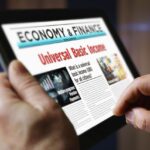
What is Sustainable Investing?
Sustainable investing is an investment style that oversees risks associated with the degradation of ecosystems and the challenges companies face as a result. As a financial advisor, there are several aspects to sustainable investing that you need to understand. To start, it would be wise to take a look at the United Nations’ 17 Sustainable Development Goals (SDGs)1 to get an idea of the scope and impact investments could make.
To view the full article please register below:
What is Sustainable Investing?
How to Service Clients Who Want to Invest Responsibly
Sustainable investing is an investment style that oversees risks associated with the degradation of ecosystems and the challenges companies face as a result. As a financial advisor, there are several aspects to sustainable investing that you need to understand. To start, it would be wise to take a look at the United Nations’ 17 Sustainable Development Goals (SDGs)1 to get an idea of the scope and impact investments could make. The SDGs are a call for action by all countries, local governments, businesses, non-government organizations and individuals working in a global partnership; together, they recognize that ending poverty, standing up for human rights and addressing other global deprivations must go hand-in-hand with the strategies that work to improve health and education, reduce inequalities, and spur economic growth—all while tackling climate change and working to preserve Earth’s precious ecosystems. These are issues that are not politically driven, but rather real-life concerns facing all humans on a global scale.
Navigating ESG Criteria/Screening and Sustainability Standards
Understanding Environmental, Social and Governance (ESG) criteria provides insight into the material, non-financial issues and risks that companies take. Not all ESG issues are material to all companies or industries. The Sustainability Accounting Standards Board (SASB) has developed a Materiality Map that clearly identifies the relationship between different industries and their material risks.2 The process of ESG screening provides transparency and meaningful data that allows financial advisors and investors to compare a company’s processes to industry standards on a minimal level. It should be noted there is still some controversy surrounding the availability and accuracy of data. However, with the increasing demand for ESG screening, the data has become more meaningful. As a result, the controversies and reputational risks that companies take are painting a different picture for investors. Furthermore, material, non-financial data can be a strong indication of long-term value.
For a mutual fund investor and/or a financial advisor, Morningstar now provides ESG ratings and disclosures on whether ESG screening is a mandate of the fund. In addition, there are screening tools, such as As You Sow, which will give you analysis of the fossil fuel, tobacco or weapons exposure of the funds.
When I screen a company or fund for inclusion in a portfolio, I review the ESG controversies and how ESG integration is included in their strategic processes, as well as fundamental analysis. ISS Analytics3 has stated that investors continue to add to the ESG list of factors they consider, including governance practices, board independence, accountability, diversity, executive compensation factors, shareholder rights, and environmental and social factors. These initiatives signal a paradigm shift in investing and capital movements.
Supporting Sustainable Investing Through Shareholder Engagement
The shareholder engagement process goes hand-in-hand with sustainable investing. As a shareholder advocate and fiduciary, engaging on behalf of my clients with portfolio managers and company representatives becomes a best practice. I cannot turn a blind eye toward things I see or that clients see. That is where my path as an Investment Advisor Representative (IAR) diverts from the norm. If a company is underperforming, I would sell it or find out why. If a company is acting irresponsibly toward their stakeholders, then—again, as a shareholder advocate and fiduciary—my clients would expect that I would communicate with the company and with them.
Sustainable investing is about actively engaging a company toward the improvement of their processes and results in an improved stakeholder experience. Would a company make those improvements without the nudging of shareholder engagement? Perhaps. As shareholders, we have the right to speak up when our investment is having a negative impact on employees, the environment, community or supply chain (e.g., the other stakeholders of a company).
A Shareholder’s Toolbox for Taking Action
Some of the tools available for shareholder engagement are the use of proxies, shareholder proposals, shareholder resolutions and discussions with management. As an IAR, I often depend on various shareholder advocacy groups to facilitate this process. Such advocacy provides an opportunity to collaborate with other firms in an effort to improve corporate processes by submitting letters and resolutions directly to directors, and providing progress on those engagements. In addition, we directly engage through letters to management and representatives of organizations, and relay that information to our clients through quarterly engagement letters, which include a discussion about current proxies. This gives us an opportunity to discuss the issues most important to our clients and creates trust.
According to Morgan Stanley’s Institute for Sustainable Investing’s 2017 Sustainable Signals report, nine out of 10 millennials (86 percent) say they want to know more about SRI or sustainable investing; furthermore, for their retirement accounts, 90 percent of this generation wants socially responsible investing options.4 For the sake of our own sustainability, it behooves us to be well versed in these trending investment styles.
Sources:
- United Nations. (2020). 17 Sustainable Development Goals. Retrieved from United Nations: https://sustainabledevelopment.un.org/sdgs
- Sustainability Accounting Standards Board. (2018). SASB Materiality Map. Retrieved from Sustainability Accounting Standards Board: https://materiality.sasb.org/
- Institutional Shareholder Services, Inc. (2020). ISS Analytics. Retrieved from https://www.issgovernance.com/solutions/iss-analytics/
- Shell, A. (2018, May 11). Millennial 401(k)s: a peek inside their “socially responsible” investments. USA Today. Retrieved from https://www.usatoday.com/story/money/2018/05/11/millennials-socially-responsible-investing/580434002/
Please reference disclosures: https://blog-dev.americanportfolios.com/disclosures/












